
The laughing gull is a medium-sized gull of North and South America. Named for its laugh-like call, it is an opportunistic omnivore and scavenger. It breeds in large colonies mostly along the Atlantic coast of North America, the Caribbean, and northern South America. The two subspecies are L. a. megalopterus — which can be seen from southeast Canada down to Central America — and L. a. atricilla, which appears from the West Indies to the Venezuelan islands. The laughing gull was long placed in the genus Larus until its present placement in Leucophaeus, which follows the American Ornithologists' Union.
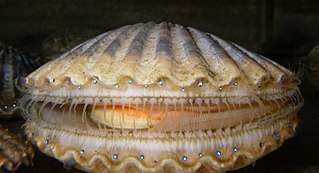
Scallop is a common name that encompasses various species of marine bivalve mollusks in the taxonomic family Pectinidae, the scallops. However, the common name "scallop" is also sometimes applied to species in other closely related families within the superfamily Pectinoidea, which also includes the thorny oysters.

Aequipecten is a genus of scallops, marine bivalve mollusks in the family Pectinidae.

Euvola ziczac, or the zigzag scallop, is a species of bivalve mollusc in the family Pectinidae. It can be found along the Atlantic coast of North America, ranging from North Carolina to the West Indies and Bermuda.

Placopecten magellanicus, previously listed as Pecten tenuicostatus and as Pecten grandis and once referred to as the "giant scallop", common names Atlantic deep-sea scallop, deep sea scallop, North Atlantic sea scallop, American sea scallop, Atlantic sea scallop, or sea scallop, is a commercially important pectinid bivalve mollusk native to the northwest Atlantic Ocean.

Musculus niger, or the black mussel, is a species of bivalve mollusc in the family Mytilidae. It can be found in the Atlantic Ocean, eastern Pacific Ocean, and the Arctic Ocean. Along the Atlantic coast of North America, it ranges from the Arctic Ocean to North Carolina.

Lithophaga aristata, or the Scissor date mussel, is a species of bivalve mollusc in the family Mytilidae. It can be found along the Atlantic coast of North America, ranging from North Carolina to Texas and the West Indies.

Euvola is a genus of marine bivalve mollusks in the family Pectinidae, the scallops. In shells of this genus, one valve is flat, and the other is deeply cupped.
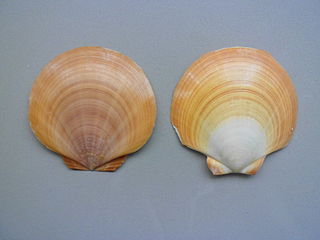
Euvola marensis, or the paper scallop, is a species of bivalve mollusc in the family Pectinidae. It can be found in the Gulf of Mexico, ranging from the West Indies to Brazil.

Nodipecten nodosus, or the lion's paw scallop, is a species of bivalve mollusc in the family Pectinidae. It can be found along the Atlantic coast of North America, ranging from Cape Hatteras to the West Indies, including Brazil and Bermuda.
Cryptopecten phrygium, the spathate scallop, is a species of bivalve mollusc in the family Pectinidae. It can be found along the Atlantic coast of North America, ranging from Cape Cod to the West Indies.
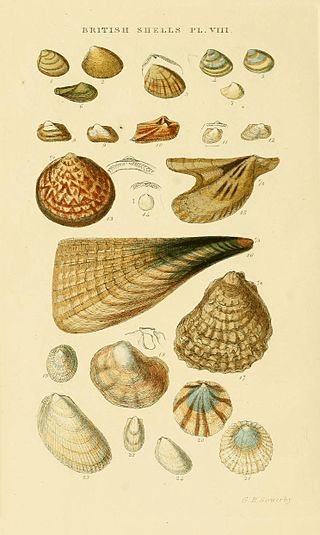
Limaria pellucida, the Antillean file shell, is a species of bivalve mollusc in the family Limidae. It can be found along the Atlantic coast of North America, ranging from North Carolina to the West Indies.
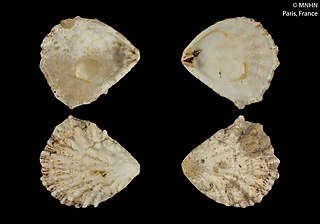
Plicatula gibbosa, commonly known as the Atlantic kitten's paw, is a species of bivalve mollusc in the family Plicatulidae.
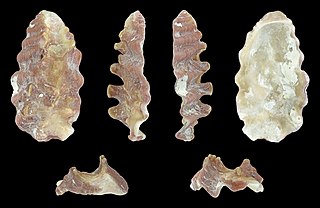
Dendostrea frons, the frond oyster, is a species of bivalve mollusc in the family Ostreidae.
Ostrea permollis, the sponge oyster, is a species of bivalve mollusc in the family Ostreidae. It can be found along the Atlantic Coast of North America, ranging from North Carolina to the West Indies.

Astarte elliptica, or the "elliptical astarte", is a species of bivalve mollusc in the family Astartidae. It can be found along the Atlantic coast of North America, ranging from Greenland to Massachusetts.
Clathrolucina costata, or the costate lucine, is a species of bivalve mollusc in the family Lucinidae. It can be found along the Atlantic coast of North America, ranging from North Carolina to the West Indies.

Chama congregata, commonly known as the corrugated jewel box clam, is a species of bivalve mollusc in the family Chamidae. It can be found along the Atlantic coast of North America, ranging from North Carolina to the West Indies and Bermuda.

Arcinella arcinella, or the Caribbean spiny jewel box clam, spiny jewel box clam, or spiny jewel box, is a species of bivalve mollusc in the family Chamidae.
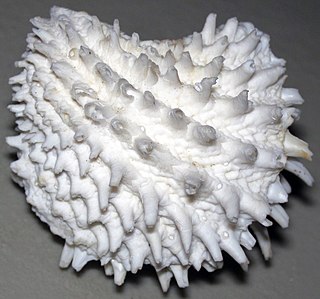
Arcinella cornuta, or the Florida spiny jewelbox clam or Florida spiny jewel box, is a marine species of bivalve mollusc in the family Chamidae. It can be found along the coast of North Carolina to Florida, Gulf of Mexico, Caribbean Central America, and Venezuela.
















